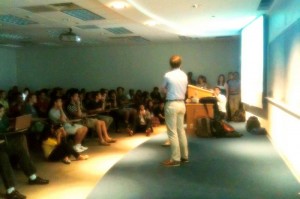This year, NAIMUN took a long, hard look at the mechanisms of chairing and crisis managing in place across the circuit and attempted to use this perspective to revolutionize the structural, technical, and thematic aspects of the conference experience. To this end, NAIMUN began a dialogue with its staff through the hosting of a number of mandatory training meetings to discuss chairing and crisis staff innovations and philosophy.
While certainly covering the basics of Robert’s Rules and committee dynamics, the examination of what it takes to run a truly incredible and innovative committee was taken a step further. NAIMUN first hosted a “chair panel” in which a number of veteran chairs discussed their philosophies regarding the activity. Topics ranged from a debate on the merits of playing the role of an “activist chair” versus one who leaves the direction of debate more in the hands of delegates to a dialogue on the methods one should use to assess awards and commendations. Many opinions were shared and dissected to their most basic kernels of value before an audience of nearly 100 staff members.
Following up on the success of this initiative NAIMUN hosted another, similarly well attended, “crisis panel.” It can be hard for delegates – so focused on in-room proceedings and intrigues – to fully grasp how central a functioning crisis staff is to the success of smaller crisis-based committees. The updates produced for the sake of the simulation, along with the colorful acting and touches of ambience, are indeed what motivate committee to action. A good crisis staff much simultaneously work on its own initiative to produce crisis spanning the entire gamut of topical possibility and build off of the literature and policy produced in committee to ensure that the delegates themselves play a vital role in motivating the contextual progression of the simulated world around them. The crisis panel featured standard instruction on the crafting of crisis updates, the presentation of new developments, and the utilization of staff, but also took the discourse a step further. A central debate presented three distinct models for crisis management – the “crisis bush” (focusing on a sporadic variety of potential crisis points), the “playbook” (categorizing updates into various spheres of functionality to be utilized at the appropriate time), and “Morshed’s Mantra” (an acceptance of the chaotic nature of crisis committees and simply developing ideas as they present themselves). Other topics included a conceptualization of a crisis as a “narrative” to run the span of the weekend, an application of crisis points in larger committees, and innovative suggestions for handling delegate interaction and notes.
The lessons learned from this series will surely be applied across the board at NAIMUN XLIX, which plans on featuring committees that push the envelope substantively and organizationally. NAIMUN’s new United States National Security Apparatus organ will begin the development of the “concurrent crisis” model, bringing committees of different sizes and structures together under a common organizational structure. The number of Middle East-focused committees will experiment and similarly pioneer new models for inter-delegate interaction, working on a “converging crisis” model. Committees as diverse as the Pacific Islands Forum, the Bilderberg Group Meeting, the Congress of Vienna, and the Yakuza Summit will explore new realms of technical simulation (through advanced war game mechanics, multi-fronted diplomatic interaction, large-scale crisis mobilization, and GA-style, personality based simulations) and substantive rigor (discussing issues of the past, present, and future, from the micro-level, to the state-building scale).
In summation, NAIMUN XLIX has sought to innovate the Model UN playbook through various means. These means include strengthened and diversified training behind the scenes, and more ambitious goals for committee substance, process, and relations. Ultimately, NAIMUN Secretariat hopes that these innovations will encourage delegates and staff alike to take on new challenges and risks while maintaining strong committee preparation.



